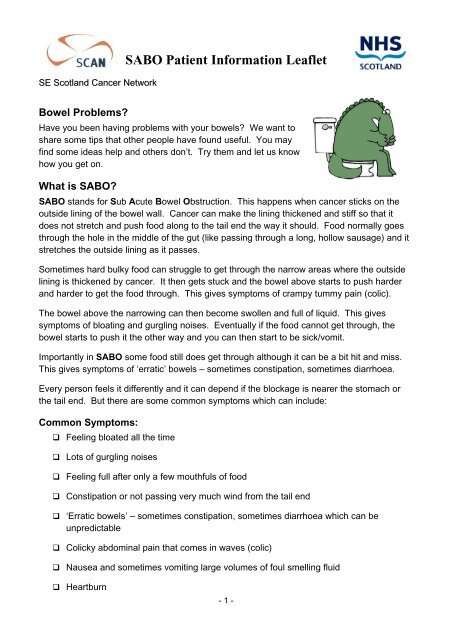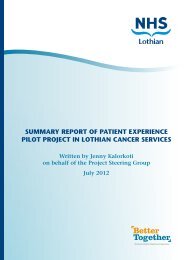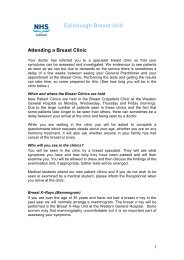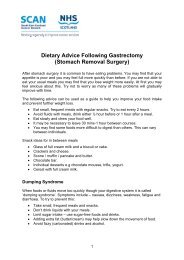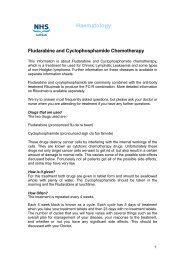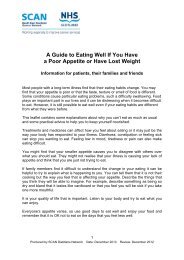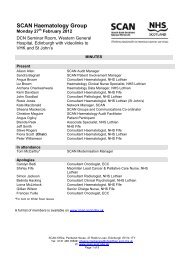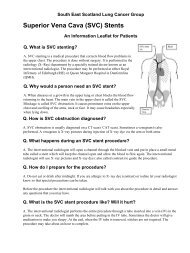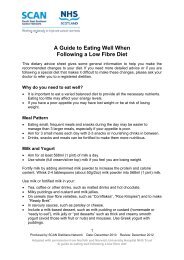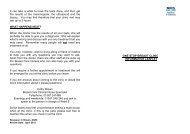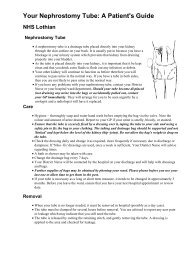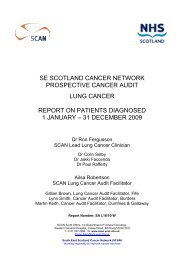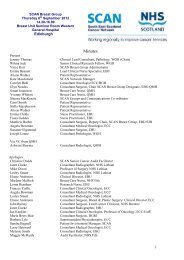SABO Patient Information Leaflet - SCAN
SABO Patient Information Leaflet - SCAN
SABO Patient Information Leaflet - SCAN
You also want an ePaper? Increase the reach of your titles
YUMPU automatically turns print PDFs into web optimized ePapers that Google loves.
SE Scotland Cancer Network<br />
<strong>SABO</strong> <strong>Patient</strong> <strong>Information</strong> <strong>Leaflet</strong><br />
Bowel Problems?<br />
Have you been having problems with your bowels? We want to<br />
share some tips that other people have found useful. You may<br />
find some ideas help and others don’t. Try them and let us know<br />
how you get on.<br />
What is <strong>SABO</strong>?<br />
<strong>SABO</strong> stands for Sub Acute Bowel Obstruction. This happens when cancer sticks on the<br />
outside lining of the bowel wall. Cancer can make the lining thickened and stiff so that it<br />
does not stretch and push food along to the tail end the way it should. Food normally goes<br />
through the hole in the middle of the gut (like passing through a long, hollow sausage) and it<br />
stretches the outside lining as it passes.<br />
Sometimes hard bulky food can struggle to get through the narrow areas where the outside<br />
lining is thickened by cancer. It then gets stuck and the bowel above starts to push harder<br />
and harder to get the food through. This gives symptoms of crampy tummy pain (colic).<br />
The bowel above the narrowing can then become swollen and full of liquid. This gives<br />
symptoms of bloating and gurgling noises. Eventually if the food cannot get through, the<br />
bowel starts to push it the other way and you can then start to be sick/vomit.<br />
Importantly in <strong>SABO</strong> some food still does get through although it can be a bit hit and miss.<br />
This gives symptoms of ‘erratic’ bowels – sometimes constipation, sometimes diarrhoea.<br />
Every person feels it differently and it can depend if the blockage is nearer the stomach or<br />
the tail end. But there are some common symptoms which can include:<br />
Common Symptoms:<br />
Feeling bloated all the time<br />
Lots of gurgling noises<br />
Feeling full after only a few mouthfuls of food<br />
Constipation or not passing very much wind from the tail end<br />
‘Erratic bowels’ – sometimes constipation, sometimes diarrhoea which can be<br />
unpredictable<br />
Colicky abdominal pain that comes in waves (colic)<br />
Nausea and sometimes vomiting large volumes of foul smelling fluid<br />
Heartburn<br />
- 1 -
What might help?<br />
• Laxatives<br />
These are essential in managing your <strong>SABO</strong>. Although you may have episodes of<br />
diarrhoea followed by constipation you will feel much more comfortable using laxatives to<br />
have a more regular, loose motion every day (or preferably more than once a day).<br />
o Movicol is one of the best but it can be a large volume to drink.<br />
o Lactulose is a gentler alternative.<br />
o Suppositories and sometimes enemas can also help get things on a more<br />
even keel.<br />
We tend to avoid laxatives that cause the guts to try to push harder (like senna, bisacodyl<br />
or danthron) as these will make the colicky pains worse.<br />
• Antisickness drugs<br />
There are a lot of different drugs that can be used to control nausea or vomiting.<br />
Sometimes it can be difficult to swallow these if you are feeling full up. Do let your<br />
specialist know if you are struggling or if you cannot manage your tablets. Even<br />
something as simple as changing to liquids instead of tablets can help but there are also<br />
drugs you that dissolve in your mouth that may help.<br />
If you take your tablets and then vomit them back up don’t be afraid to take another dose.<br />
If you can see the tablet it has not done much good. As a rule of thumb, if you see it or if<br />
you are sick within half an hour of taking your medicine, repeat the dose if you can.<br />
If your bowels are not working at all well then swallowing even the best medicine and<br />
being sick is not going to work and using a jag (an injection) will help. We often use a<br />
special device called a subcutaneous pump that can give you the same as a jag only<br />
over 24 hours every day. It can be filled up once a day by the district nurse. It is quite<br />
small (about the size of mobile phone) and it is attached to a plastic needle that stays<br />
under the skin in your upper arm. You can carry it about and no-one will know.<br />
• Pain relief<br />
There are many painkillers that will help with the colicky pain.<br />
o Buscopan tablets are used for mild pain. These work best if they are taken<br />
regularly rather than waiting for a bout of pain to arrive.<br />
o Paracetamol again can be useful if used four times a day rather than just<br />
when needed.<br />
- 2 -
We can prescribe much stronger pain killers but many of them can cause constipation as<br />
a side effect and your laxatives may need to be increased.<br />
o There are strong pain relieving patches, worn on the skin, called fentanyl,<br />
which you do not need to swallow.<br />
We can also put the pain killers in the pump described above so you do not have to<br />
swallow them.<br />
• Steroids<br />
Short, sharp courses of steroids can help settle a bad bout of <strong>SABO</strong>. Steroids work by<br />
calming down the swelling around the narrowed areas and allowing the food to go<br />
through better. Talk to your specialist about having a 5 day course of oral steroids.<br />
o Dexamethasone is often used as you can dissolve the tablets in a little liquid<br />
to make them easy to swallow. If they are used in short, sharp courses there<br />
are fewer side effects, like weight gain, but it can make your heartburn worse.<br />
Try and take your steroids early in the day as they can keep you awake at night.<br />
However they are best taken when you are least likely to vomit. If you are not able to<br />
swallow, these may be given in a drip.<br />
• Heartburn<br />
This can make you miserable so don’t suffer in silence.<br />
o Omeprazole and lansoprazole are very good antacid medicines that can help.<br />
These may need to be taken twice a day.<br />
• ‘Resting the gut’<br />
If you are having a bad bout of <strong>SABO</strong>, it can sometimes help to give the gut a break.<br />
This means taking fluids only for 24 hours. Remember to take sugary drinks as you<br />
absorb much more water from them than just plain water.<br />
If you are feeling rotten it can help to have 24 hours of a drip in hospital to completely rest<br />
the gut. Why not talk to your nurse specialist or oncologist? Talk over what to do when<br />
and who to call if things are not settling.<br />
• Mouth care<br />
When you are feeling or being sick your mouth can taste horrible. Take extra special<br />
care with a mouth wash you like; ice cubes to suck can be great. It can be easy to get<br />
oral thrush when you are run down so look for any white areas sticking to the inside lining<br />
of your mouth. If you have this – there are special tablets and mouthwashes to use to<br />
make things better.<br />
- 3 -
I have been told about a diet that can help – what is this?<br />
Low Fibre Diet<br />
This can sound strange; we are recommending cutting out a lot of things that you have been<br />
told are good for you – but it works! The dietary advice which follows will give you some tips<br />
but the basic idea is to cut out foods that will make your bowel motions big, hard and bulky.<br />
These bulky stools find it much harder to pass through any area of narrowing. Liquidy stools<br />
are your friend.<br />
Practical tips about your diet<br />
As well as following a Low Fibre Diet, here are some tips that can help.<br />
• Eat small servings. You probably already do this. If your appetite is poor it may be<br />
helpful to use a small plate.<br />
• Eat frequently. Try the ‘grazing’ approach. ‘Little and often’ is best. 5 or 6 small meals<br />
or snacks may work better than 3 meals a day.<br />
• Choose softer foods they may be easier to manage.<br />
• Avoid nuts, raw/dried fruits and vegetables including seeds, pips and skins.<br />
• Keep up your fluids. High calorie, high protein drinks are the best e.g. Full cream milk,<br />
milkshakes<br />
• Choose a variety of foods from the low fibre food choices below. Experiment! A boring<br />
diet is tedious. Food is meant to be a pleasure. Experiment with flavourings such as<br />
herbs, onion salt, tomato puree, soy sauce, infused vegetable or olive oils.<br />
• Take a multivitamin/mineral supplement as it can be hard to get all the necessary<br />
vitamins and minerals if you are not managing a full range of foods.<br />
• Your GP may be able to prescribe supplement drinks for you if your appetite is poor. Try<br />
to take these in addition to your meals and snacks.<br />
• Try reintroducing your favourite foods in small amounts. Half a strawberry is fine! You<br />
are the best expert on your gut. Remember, above all, that these are only guidelines and<br />
it is better for you to eat something. You will quickly find out which foods suit you best. If<br />
you have a bout of <strong>SABO</strong> try and look at what may have brought it on.<br />
- 4 -
After a bout of <strong>SABO</strong>, as your symptoms improve, re-introduce foods into your diet one at a<br />
time and in small amounts.<br />
It may be useful to try the following steps as a guide;<br />
1. Clear fluids - tea/coffee (no milk), fruit tea, cordial/squash, fruit juice (smooth),<br />
Bovril/Oxo/Marmite drinks.<br />
2. Free Fluids - milk, custard, soups (clear, consommé, cream).<br />
3. Low Fibre diet - Gradually re-introduce low fibre foods from the list below. If you do<br />
this you can often spot which foods upset you.<br />
High Fibre Foods<br />
(Limit these)<br />
Bread & Rolls<br />
Wholemeal, granary, rye.<br />
Cereals<br />
All Bran, Branflakes, Muesli, Porridge,<br />
Weetabix, Shredded Wheat.<br />
Low Fibre Alternatives<br />
(Try to choose these)<br />
Bread & Rolls<br />
White or smooth textured. White pitta or<br />
naan bread.<br />
Cereals<br />
Rice Krispies, Cornflakes, Special K, Ready<br />
Brek, Strained porridge.<br />
Pasta and Rice<br />
Wild or brown rice, whole-wheat pasta.<br />
Pasta and Rice<br />
White rice, pasta, noodles, cous cous, rice<br />
cakes.<br />
Starchy foods<br />
Wholemeal flour and flour products;<br />
fruit/bran/wholemeal scones, flapjacks, fruit<br />
cake, cakes with nuts e.g. carrot cake,<br />
wholemeal biscuits e.g. digestive, oatcakes.<br />
Starchy foods<br />
White flour and flour products;<br />
cornflour, plain/cheese/treacle soda scones,<br />
sponge cake, pancakes, plain biscuits e.g.<br />
cream crackers, rich tea, cream biscuits.<br />
- 5 -
High Fibre Foods<br />
(Limit these)<br />
Meat, Fish, Poultry & Eggs<br />
Casseroles or stews with onions and<br />
vegetables, chilli, curry. Tough meats,<br />
sausages, burgers, haggis.<br />
Fish with small bones e.g. herrings, sardines.<br />
Pulses e.g. peas, baked beans, kidney<br />
beans and lentils.<br />
Low Fibre Alternatives<br />
(Try to choose these)<br />
Meat, Fish, Poultry & Eggs<br />
Meat—any type including poultry and offal.<br />
Choose well cooked/soft varieties.<br />
Eggs.<br />
Fish—all other varieties.<br />
Tofu and Quorn.<br />
Milk and Milk Products<br />
Cheese, yoghurt and ice cream containing<br />
fruit, nuts or cereals.<br />
Fruit and Vegetables<br />
Dried Fruit, nuts, skins and seeds. All fresh<br />
fruit except those listed opposite.<br />
Sweetcorn, onion, potato skins,<br />
All raw vegetables and salads. All other<br />
vegetables except those listed opposite.<br />
Miscellaneous<br />
Soups with vegetables or pulses.<br />
Popcorn.<br />
Coconut.<br />
Toffee or chocolate containing dried fruit or<br />
nuts.<br />
Peanut butter.<br />
Milk and Milk Products<br />
Milk, cream, butter, cheese, ice cream,<br />
yoghurt and milk puddings.<br />
Fruit and Vegetables<br />
Fruit or vegetable juice.<br />
Soft tinned fruits e.g. peaches.<br />
Stewed soft fruit e.g. apple.<br />
Potato– mashed, boiled, roast, chips. Small<br />
amounts of carrot, turnip, squash, beetroot,<br />
cauliflower tops. These should be well<br />
cooked.<br />
Miscellaneous<br />
Clear, strained or cream soups. Bouillon,<br />
consommé.<br />
Tea, coffee, squash, cordials, boiled sweets,<br />
chocolate, fudge, toffee.<br />
Seedless jam, rindless marmalade, honey,<br />
syrup, smooth chocolate spread, lemon curd.<br />
- 6 -
What about surgery?<br />
The peritoneal lining covers everything and you cannot remove it without removing the bowel<br />
it is covering. Because it is often not just one area of the bowel that is narrowed surgery<br />
often will not help. However, a CT scan taken after you drink some contrast liquid (a type of<br />
dye) can help to see if only one area is affected. We can watch the dye going through your<br />
gut. If there is just one area of narrowing your specialist will advise you of the benefits and<br />
risks of surgery, or if a special plastic tube (called a stent) may help. Sometimes, if the<br />
bowel is completely blocked, surgery can be used to bring out the bowel above the<br />
narrowing. This is called a stoma.<br />
However, most episodes of <strong>SABO</strong> are not so dramatic and there are tricks to try with both<br />
medicines and diet. <strong>SABO</strong> often comes in ‘bouts’. You may be fine for a while and then<br />
have several days of symptoms before things settle again.<br />
The good news is – with time we find that most people can avoid really severe bouts and the<br />
need to come into hospital. We want you to have the confidence to manage your own<br />
symptoms with time. It can all seem too much at first but we are here to help. Please Ask!<br />
Other information<br />
Ask for the <strong>SCAN</strong> leaflet on ‘nourishing drinks’<br />
Here are some other websites to look at for more tips and diet advice<br />
http://www.bccancer.bc.ca/NR/rdonlyres/01B68B82-61CD-45A4-B71D-<br />
37A5A1318453/9329/LowFibreFoodChoicesPartialBowelObstruction1.pdf<br />
http://www.cancernorth.nhs.uk/livingwithcancer/Symptomsandsideeffects/Diarrhoea/Morelow<br />
fibredietideas<br />
http://www.christie.nhs.uk/patients/treatments/pmp/diet.aspx<br />
Published: Sept 2009<br />
Review date: Sept 2010<br />
- 7 -


